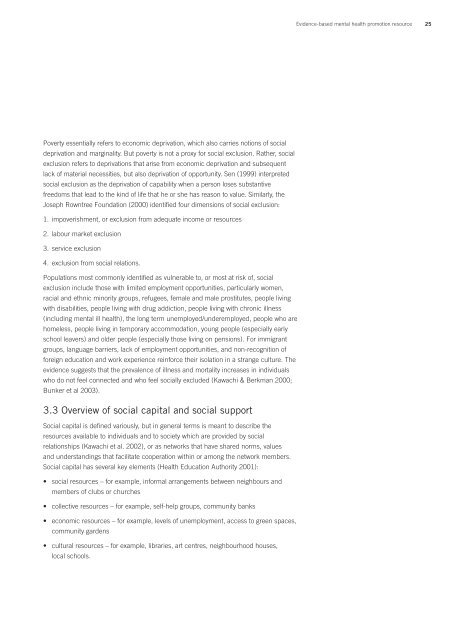<strong>Evidence</strong>-<strong>based</strong> <strong>mental</strong> <strong>health</strong> <strong>promotion</strong> <strong>resource</strong>25Poverty essentially refers to economic deprivation, which also carries notions of socialdeprivation and marginality. But poverty is not a proxy for social exclusion. Rather, socialexclusion refers to deprivations that arise from economic deprivation and subsequentlack of material necessities, but also deprivation of opportunity. Sen (1999) interpretedsocial exclusion as the deprivation of capability when a person loses substantivefreedoms that lead to the kind of life that he or she has reason to value. Similarly, theJoseph Rowntree Foundation (2000) identified four dimensions of social exclusion:1. impoverishment, or exclusion from adequate income or <strong>resource</strong>s2. labour market exclusion3. ser<strong>vic</strong>e exclusion4. exclusion from social relations.Populations most commonly identified as vulnerable to, or most at risk of, socialexclusion include those with limited employment opportunities, particularly women,racial and ethnic minority groups, refugees, female and male prostitutes, people livingwith disabilities, people living with drug addiction, people living with chronic illness(including <strong>mental</strong> ill <strong>health</strong>), the long term unemployed/underemployed, people who arehomeless, people living in temporary accommodation, young people (especially earlyschool leavers) and older people (especially those living on pensions). For immigrantgroups, language barriers, lack of employment opportunities, and non-recognition offoreign education and work experience reinforce their isolation in a strange culture. Theevidence suggests that the prevalence of illness and mortality increases in individualswho do not feel connected and who feel socially excluded (Kawachi & Berkman 2000;Bunker et al 2003).3.3 Overview of social capital and social supportSocial capital is defined variously, but in general terms is meant to describe the<strong>resource</strong>s available to individuals and to society which are provided by socialrelationships (Kawachi et al. 2002), or as networks that have shared norms, valuesand understandings that facilitate cooperation within or among the network members.Social capital has several key elements (Health Education Authority 2001):• social <strong>resource</strong>s – for example, informal arrangements between neighbours andmembers of clubs or churches• collective <strong>resource</strong>s – for example, self-help groups, community banks• economic <strong>resource</strong>s – for example, levels of unemployment, access to green spaces,community gardens• cultural <strong>resource</strong>s – for example, libraries, art centres, neighbourhood houses,local schools.
26 <strong>Evidence</strong>-<strong>based</strong> <strong>mental</strong> <strong>health</strong> <strong>promotion</strong> <strong>resource</strong>The synergy model of social capital identified by Woolcock (2001) has value for <strong>mental</strong><strong>health</strong> <strong>promotion</strong> work, although stronger research evidence is needed of how thecomponents of social capital can be created and sustained. Intra-community capital,or bonding capital, refers to the intimate relationships and connections among familymembers, close friends and neighbours. Intercommunity capital, or bridging capital,refers to the ties across communities and groups (non-local), but can also refer to localties formed among work colleagues and associates, acquaintances and distant friends.Linking capital refers to the connections among organisations, ser<strong>vic</strong>es and membersof a community, or among groups even if they have differing levels of social status andpower (Putnam 2001). While much scholarship has developed knowledge about howto develop local communities, less is known about how to create networks across andbetween communities, or across difference, in ways that benefit vulnerable people.Social capital and social networks are seen as a resonant measure of communitystrength (Johnson, Headey & Jensen 2003) and as vehicles for turning the tide ofcommunity decline. Changes occur through the regeneration of social and economicbenefits from relationships among neighbours, citizens and <strong>gov</strong>ernments, which in turnare relationships <strong>based</strong> on strong norms of trust and reciprocity. Important distinctions,however, are made between theorised and empirical understandings of social capital(Johnson, Headey & Jensen 2003; Stone 2001), and the definitions are much debatedfor their ideological implications.Social capital has societal and structural dimensions. There is wide agreement thatstrong communities and levels of social capital are associated with ci<strong>vic</strong> engagement andstronger democracy, improved early childhood outcomes, improved <strong>mental</strong> and physical<strong>health</strong>, and improved local economic performance (Johnson, Headey and Jensen2003). There is continuing interest in the concept of social capital, although interventionresearchers of social capital tend to accord greater significance to psychosocialfactors than material deprivation. Yet, income inequality, for example, is critical forunderstanding social capital bec<strong>au</strong>se it creates stress and damages social capital.Social connectedness and social capital are key determinants of <strong>mental</strong> and physical<strong>health</strong> and inequity. People are most commonly connected to family, schools, work anddifferent types of community group, club and organisation. But social connectednessand social capital are not necessarily present in every community, with resulting socialisolation. As determinants, they indicate the need for a progressive agenda from<strong>gov</strong>ernments to make strategic investments in social and economic development. Thestrength of the relationships between social and structural conditions and <strong>mental</strong> <strong>health</strong>has been understood for some years, with strong associations made between poor<strong>mental</strong> <strong>health</strong> and unemployment, poverty, discrimination, social exclusion, violenceand lack of social connectedness. It is not common, however, to see sufficient politicalwill for tackling those social–structural issues to support the <strong>promotion</strong> of <strong>mental</strong> <strong>health</strong>or prevent <strong>mental</strong> ill <strong>health</strong>.



